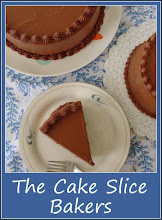 I’m off on holiday to Chicago tomorrow!! I’m SO excited as I’ve never been to America before and can’t wait to eat my way around all the bakeries and cupcake shops. I won’t be posting for about two weeks but wanted to leave you with a lovely summery strawberry dessert in the hope that by the time I get back the weather might have improved as it’s currently pouring with rain.
I’m off on holiday to Chicago tomorrow!! I’m SO excited as I’ve never been to America before and can’t wait to eat my way around all the bakeries and cupcake shops. I won’t be posting for about two weeks but wanted to leave you with a lovely summery strawberry dessert in the hope that by the time I get back the weather might have improved as it’s currently pouring with rain.This was the dessert I made with some of the remaining glut of strawberries I had leftover from the Pick-Your-Own trip I mentioned a few posts back. I wanted something that would really show off the freshness of the strawberries and concocted this dessert. The strawberries are used three times, once in the mousse, again as a fresh fruit central layer and finally as strawberry jam – of which I used my own homemade jam.

I decided to make individual desserts by layering the components in metal ring moulds and glasses, but you could easily just use one big glass dish if you wanted. The dessert comprised of a whisked fatless sponge base which was spread with a little homemade strawberry jam, followed by a ring of fresh strawberries, topped with an incredibly light and airy strawberry mousse and finished with a little extra jam to give it a nice vibrant shine. All the components were soft and light and each mouthful was bursting with the very essence of ripe strawberries.
Strawberry Mousse Dessert
 Strawberry Mousse
Strawberry Mousse350g strawberries
3 egg whites
150ml double cream
120g caster sugar
Whisked Sponge
4 eggs
125g caster sugar
125g plain flour
2 tbsp hot water
1 tsp vanilla
Assembly
250g fresh strawberries
8 tbsp strawberry jam
Start by making the sponge
 Preheat the oven to 190C and line a 20cm x 30cm swiss roll tin with baking paper.
Preheat the oven to 190C and line a 20cm x 30cm swiss roll tin with baking paper.Whisk the eggs, vanilla, water and sugar together until pale and tripled in volume. This should take about 4 minutes and a ‘ribbon’ of batter should remain visible for a few seconds if streaked across the surface.
Sift over the flour and use a large metal spoon to carefully fold it through the batter, until no flour streaks remain. Don’t over mix as you want to preserve as many air bubbles as possible.
Pour the batter into the lined tray and level out the surface.
Bake for 12-15 minutes until lightly golden and springy to the touch. Lay another piece of greaseproof paper on a cooling wire and dust the top with icing sugar. Invert the sponge onto the dusted paper and carefully peel off the bottom paper. Cover with a clean tea towel and leave to cool before using.
To make the mousse
 Destalk the strawberries and blitz them in a food processor until smooth. Press the puree though a sieve to remove most of the seeds and set aside.
Destalk the strawberries and blitz them in a food processor until smooth. Press the puree though a sieve to remove most of the seeds and set aside.Place the egg whites in a clean bowl set over a pan of simmering water. Whisk until light, airy and soft peaks are forming. While continuing to whisk, add the sugar a little at a time until the mixture forms a thick and glossy meringue. Remove the bowl from the heat and continue to whisk until cooled.
In a large bowl, whip the double cream to stiff peak stage before whisking in the strawberry puree. Add a quarter of the meringue to the strawberry cream and fold together to slacken the mix before gently folding in the rest of the meringue to create a soft strawberry mousse.
To assemble the dessert
 Wrap the bases of 8 deep ring moulds with cling film or have 8 tumbler glasses to hand. Cut out circles of sponge and place in the base of the moulds or glasses.
Wrap the bases of 8 deep ring moulds with cling film or have 8 tumbler glasses to hand. Cut out circles of sponge and place in the base of the moulds or glasses.Heat the strawberry jam until soft and spread a teaspoonful over the tops of the sponges.
Destalk the remaining strawberries and cut in half. Place a ring of cut strawberries around the edge of the moulds or glasses, with the cut side facing out. Place another strawberry in the centre if space allows.
Spoon the strawberry mousse over the layer of strawberries until completely covered. Shake and tap the moulds/glasses gently to ensure the mousse spreads down between the strawberries. (Divide any leftover mousse between small ramekins or glasses).
Carefully spread the remaining strawberry jam over the top of the mousse. Cover with clingfilm and refrigerate for at least 4 hours to firm up before serving.
When ready to serve, remove the bottom layer of cling film from the ring moulds and place on a serving plate. Run a hot knife around the very top of the mousse and gently remove the ring. Serve with extra strawberries on the side. Any desserts made in glasses can be eaten straight from the glass.
Note: Do not attempt to place any strawberries on top of the turned out strawberry mousses, as the weight will cause the mousse to collapse.
Serves 8




 I really enjoyed making my own blueberry preserve for this cake, rather than relying on a jar. Quite a thin spreading is used to sandwich the cakes together and as it’s the only filling I initially thought it looked a little stingy but the depth and intensity of the blueberry flavour really shone through and it was more than sufficient. I loved its deep purple colour too, a perfect contrast to the pale creamy cake layers and frosting.
I really enjoyed making my own blueberry preserve for this cake, rather than relying on a jar. Quite a thin spreading is used to sandwich the cakes together and as it’s the only filling I initially thought it looked a little stingy but the depth and intensity of the blueberry flavour really shone through and it was more than sufficient. I loved its deep purple colour too, a perfect contrast to the pale creamy cake layers and frosting.
 Lemon Cake Layers
Lemon Cake Layers 375g blueberries, fresh or frozen
375g blueberries, fresh or frozen 225g caster sugar
225g caster sugar



 If you are wanting to make your own jams using fruit that’s low in pectin then it’s best to try and combine it with a fruit that’s high in pectin. This is why you might often see blackberry and apple jam, for not only do they taste good together but the high pectin apple helps set and low pectin blackberries.
If you are wanting to make your own jams using fruit that’s low in pectin then it’s best to try and combine it with a fruit that’s high in pectin. This is why you might often see blackberry and apple jam, for not only do they taste good together but the high pectin apple helps set and low pectin blackberries. Ingredients
Ingredients







 Ingredients
Ingredients


 Ingredients
Ingredients



